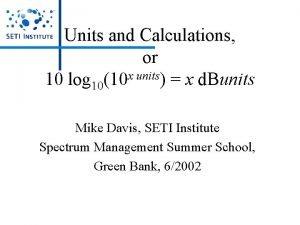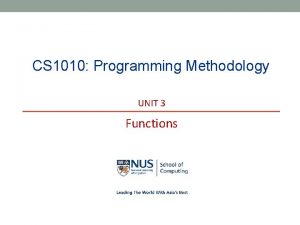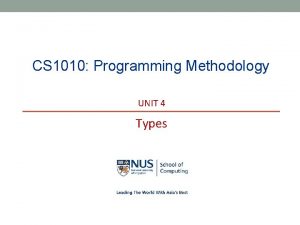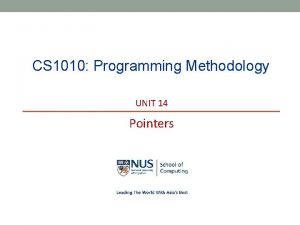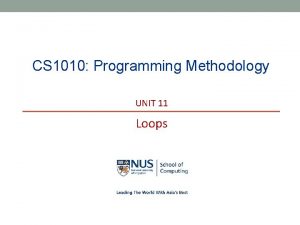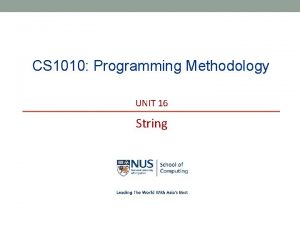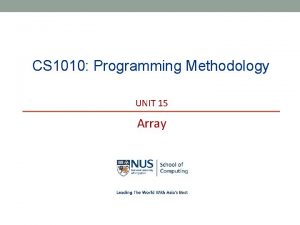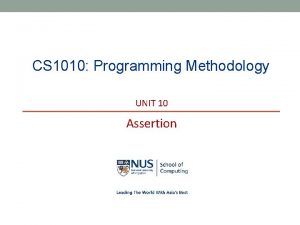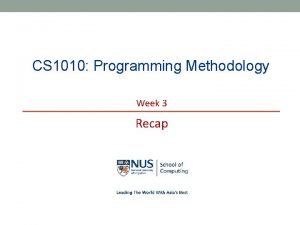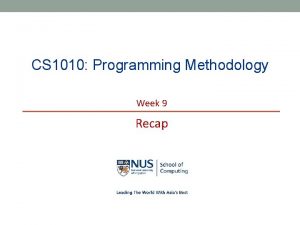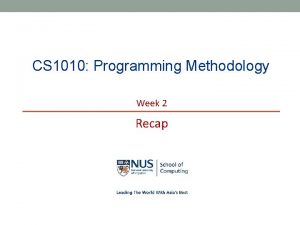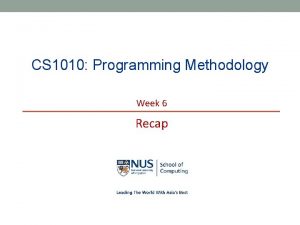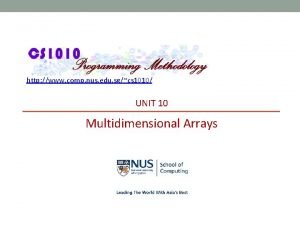CS 1010 Programming Methodology UNIT 24 Sorting NUS






![© NUS Counting Sort: Implementation void counting_sort(const long in[], long out[], long len){ long © NUS Counting Sort: Implementation void counting_sort(const long in[], long out[], long len){ long](https://slidetodoc.com/presentation_image_h2/822922b1df1468023e2c4e1fc7188c0e/image-7.jpg)




![© NUS Selection Sort: Implementation long max(long last, const long list[]){ long max_so_far = © NUS Selection Sort: Implementation long max(long last, const long list[]){ long max_so_far =](https://slidetodoc.com/presentation_image_h2/822922b1df1468023e2c4e1fc7188c0e/image-12.jpg)




![© NUS Bubble Sort: Implementation void bubble_pass(long last, long a[]){ for (long i = © NUS Bubble Sort: Implementation void bubble_pass(long last, long a[]){ for (long i =](https://slidetodoc.com/presentation_image_h2/822922b1df1468023e2c4e1fc7188c0e/image-17.jpg)





![© NUS Insertion Sort: Implementation void insert(long a[], long curr){ long i = curr © NUS Insertion Sort: Implementation void insert(long a[], long curr){ long i = curr](https://slidetodoc.com/presentation_image_h2/822922b1df1468023e2c4e1fc7188c0e/image-23.jpg)

- Slides: 24

CS 1010: Programming Methodology UNIT 24 Sorting

© NUS Unit 24: Sorting 1. 2. 3. 4. 5. Sorting Counting Sort Selection Sort Bubble Sort Insertion Sort Unit 24 - 2

© NUS Unit 24 - 3 Sorting § Sorting is any process of arranging items in some sequence and/or in different sets – Wikipedia. § Sorting is important because once a set of items is sorted, many problems (such as searching) become easy. § Searching can be speeded up. (From linear search to binary search) § Determining whether the items in a set are all unique. § Finding the median item in a list. § Many others…

© NUS Unit 24 - 4 Sorting § Problem statement: Given a list of n items, arrange the items in some order. § We will § Sort integers in increasing order. § Show 4 algorithms for sorting. § Analyze the time complexity of the algorithms.

© NUS Unit 24 - 5 Counting Sort § Introduced back in Assignment 3 § Given a list of integers in [1, MAX] § Count how many times each number appear in the list, e. g. , how many times 2 appears in the list, etc. § Store each number into an array according to how many times they appear in the list, skipping those numbers which do not appear.

© NUS Unit 24 - 6 Counting Sort A list of 5 items in the range of [1, 9] in [0] [1] [2] [3] [4] [5] 5 5 3 2 8 2 freq [0] [1] [2] [3] [4] [5] [6] [7] [8] [9] 0 0 2 1 0 2 0 0 1 0 out [0] [1] [2] [3] [4] [5] 2 2 3 5 5 8 10 slots in the freq array.
![NUS Counting Sort Implementation void countingsortconst long in long out long len long © NUS Counting Sort: Implementation void counting_sort(const long in[], long out[], long len){ long](https://slidetodoc.com/presentation_image_h2/822922b1df1468023e2c4e1fc7188c0e/image-7.jpg)
© NUS Counting Sort: Implementation void counting_sort(const long in[], long out[], long len){ long freq[MAX + 1] = { 0 }; for (long i = 0; i < len; i += 1) { freq[in[i]] += 1; } long outpos = 0; for (long i = 0; i <= MAX; i += 1) { for (long j = outpos; j < outpos + freq[i]; j += 1) { out[j] = i; } outpos += freq[i]; } } Unit 24 - 7

© NUS Unit 24 - 8 Counting Sort: Performance § Let say the length of the list is n. § The calculation of frequencies takes O(n) time § The output is done in nested loop § Outer loop takes O(MAX) iteration § The total number of output done in the inner loop is O(n) since every number in the list is output only once. § Total: O(n + MAX + n) = O(n + MAX)

© NUS Unit 24 - 9 Selection Sort § Selection Sort algorithm Step 1: Find the maximum element in the list Step 2: Swap this smallest element with the element in the last position. (Now, the largest element is in the right place. ) Step 3: Repeat steps 1 and 2 with the list having one fewer element (i. e. , the largest element / the last position can be ignored).

© NUS Unit 24 - 10 Selection Sort n=9 1 st pass: last max array [0] [1] [2] [3] [4] [5] [6] [7] [8] 23 17 5 90 12 44 38 84 77 max last 2 nd pass: 23 17 5 77 12 44 max 3 rd pass: 23 17 5 77 38 84 90 77 84 90 last 12 44 max last 4 th pass: 23 17 5 38 12 44

© NUS Unit 24 - 11 Selection Sort Q: How many passes for an array with n elements? n=9 5 th pass: 23 17 5 max 6 th pass: 7 th pass: 23 12 n – 1 passes max last 38 12 44 77 84 90 12 38 44 77 84 90 last 17 5 max last 17 5 23 38 44 77 84 90 max last 8 th pass: Final array: 12 5 17 23 38 44 77 84 90 5 12 17 23 38 44 77 84 90
![NUS Selection Sort Implementation long maxlong last const long list long maxsofar © NUS Selection Sort: Implementation long max(long last, const long list[]){ long max_so_far =](https://slidetodoc.com/presentation_image_h2/822922b1df1468023e2c4e1fc7188c0e/image-12.jpg)
© NUS Selection Sort: Implementation long max(long last, const long list[]){ long max_so_far = list[0]; long max_index = 0; for (long i = 1; i <= last; i += 1) { if (list[i] > max_so_far) { max_so_far = list[i]; max_index = i; } } return max_index; } void selection_sort(long length, long list[]){ for (long i = 1; i < length; i += 1) { long max_pos = max(length - i, list); if (max_pos != length - i) { swap(&list[max_pos], &list[length - i]); } } } Unit 24 - 12

© NUS Unit 24 - 13 Selection Sort: Performance § Let say the length of the list is n. § The for loop in selection sort iterates O(n) times. § In each loop, it finds the maximum element, and swaps. § Finding the index of the maximum element from list[0] to list[n - i] takes O(n - i) time. § Swapping (once only) takes constant time (and can be ignored). § Total: O(n 2) Pass #comparisons 1 n– 1 2 n– 2 3 n– 3 … … n– 1 1

© NUS Unit 24 - 14 Selection Sort vs Counting Sort § Selection Sort: O(n 2) § Counting Sort: O(n + MAX) § Counting Sort is a lot more efficient! § But it requires the input numbers < MAX and MAX cannot be too large. § Otherwise it does not work / is not efficient. § Selection Sort does not make assumption on the input numbers and is a more general solution.

© NUS Unit 24 - 15 Bubble Sort § Selection sort makes one exchange at the end of each pass. § What if we make more than one exchange during each pass? § The key idea Bubble sort is to make pairwise comparisons and exchange the positions of the pair if they are in the wrong order.

© NUS Unit 24 - 16 Bubble Sort: One Pass 0 1 23 17 2 3 5 4 5 6 7 8 90 12 44 38 84 77 17 5 exchange 17 23 5 exchange 90 12 44 38 84 77 17 5 exchange 17 5 23 12 44 38 90 84 77 exchange 23 90 12 44 38 84 77 ok 23 12 44 90 38 84 77 17 5 23 12 44 38 84 90 77 exchange 23 12 90 44 38 84 77 exchange 17 5 23 12 44 38 84 77 90 Q: Is the array sorted? Q: What have we achieved? Done!
![NUS Bubble Sort Implementation void bubblepasslong last long a for long i © NUS Bubble Sort: Implementation void bubble_pass(long last, long a[]){ for (long i =](https://slidetodoc.com/presentation_image_h2/822922b1df1468023e2c4e1fc7188c0e/image-17.jpg)
© NUS Bubble Sort: Implementation void bubble_pass(long last, long a[]){ for (long i = 0; i < last; i += 1) { if (a[i] > a[i+1]) { swap(a, i, i+1); } } } void bubble_sort(long n, long a[]) { for (long last = n - 1; last > 0; last -= 1) { bubble_pass(last, a); } } Unit 24 - 17

© NUS Unit 24 - 18 Bubble Sort: Performance § Let say the length of the list is n. § Bubble sort requires O(n) passes for an array with n elements. § In each pass, it compares and swaps § The number of comparisons is O(n - i). § The number of swaps is not fixed but no more than the number of comparisons. § Total: O(n 2) Pass #comparisons 1 n– 1 2 n– 2 3 n– 3 … … n– 1 1

© NUS Unit 24 - 19 Insertion Sort § In a card game, we don’t normally sort our cards using Bubble Sort or Selection sort. (Just imagine that!) § The closer algorithm we use is perhaps Insertion Sort. § The idea is to keep inserting the new card into the correct position among the existing cards.

© NUS Unit 24 - 20 Insertion Sort § Algorithm § Given an array a, on pass i, § Insert a[i] into the correct position in the sorted region to its left, i. e. a[0] … a[i-1] § Example: pass 1 (assume n = 5) § Compare a[1] with a[0] § If a[1] < a[0], move a[1] to the front of a[0] (shifting needed) § The sorted region now consists of two elements: a[0] and a[1].

© NUS Unit 24 - 21 Insertion Sorted region a § Pass 1 § Pass 2 [0] [1] [2] [3] [4] 10 5 7 1 6 5 10 7 1 6 5 7 10 1 6 Where to insert a[1] in the sorted region to its left? Where to insert a[2] in the sorted region to its left?

© NUS Unit 24 - 22 Insertion Sorted region a § Pass 3 § Pass 4 [0] [1] [2] [3] [4] 5 7 10 1 6 1 5 7 10 6 1 5 6 7 10 Where to insert a[3] in the sorted region to its left? Where to insert a[4] in the sorted region to its left?
![NUS Insertion Sort Implementation void insertlong a long curr long i curr © NUS Insertion Sort: Implementation void insert(long a[], long curr){ long i = curr](https://slidetodoc.com/presentation_image_h2/822922b1df1468023e2c4e1fc7188c0e/image-23.jpg)
© NUS Insertion Sort: Implementation void insert(long a[], long curr){ long i = curr - 1; long temp = a[curr]; while (i >= 0 && temp < a[i]) { a[i+1] = a[i]; i -= 1; } a[i+1] = temp; } void insertion_sort(long n, long a[]) { for (long curr = 1; curr < n; curr += 1) { insert(a, curr); } } Unit 24 - 23

© NUS Unit 24 - 24 Homework n Check Visualgo for animations: https: //visualgo. net/bn/sorting n Post-Lecture Diagnostic Quiz and Assignment 6 n n Due on Friday of Week 10, 4 pm Problem Set 23 -24 n To be discussed in Week 11 during tutorials.
 Internal sorting and external sorting
Internal sorting and external sorting Perbedaan linear programming dan integer programming
Perbedaan linear programming dan integer programming Greedy vs dynamic programming
Greedy vs dynamic programming Windows 10 system programming, part 1
Windows 10 system programming, part 1 Integer programming vs linear programming
Integer programming vs linear programming Definisi integer
Definisi integer Lied 769 eens als de bazuinen klinken
Lied 769 eens als de bazuinen klinken John 10:10nkjv
John 10:10nkjv Fischione 1010 ion mill
Fischione 1010 ion mill 1010 101
1010 101 Williams w-1010
Williams w-1010 Ast 1010
Ast 1010 Ast1010
Ast1010 Braun multimix 1 hm 1010 wh
Braun multimix 1 hm 1010 wh Eesc 1010
Eesc 1010 Computer systems engineering carleton
Computer systems engineering carleton 1 10 11 100 101 110 111 1000 1001 1010
1 10 11 100 101 110 111 1000 1001 1010 English 1010 slcc
English 1010 slcc Psychology 1010 midterm
Psychology 1010 midterm Siya ang nagtatag ng imperyong mali
Siya ang nagtatag ng imperyong mali Itec 1010
Itec 1010 Ley 1010/06
Ley 1010/06 10log10
10log10 Eli 1010 spectrum
Eli 1010 spectrum Fleischmarkt 1 1010 wien
Fleischmarkt 1 1010 wien






















